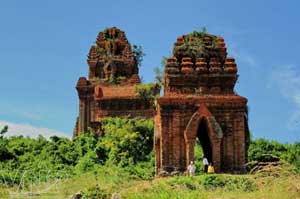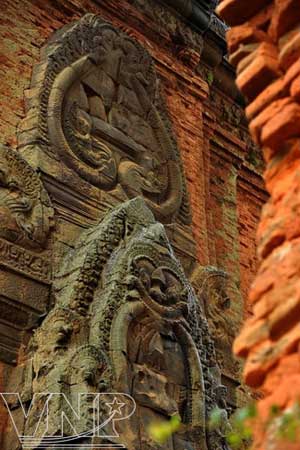Binh Dinh province was the center of the ancient Champa kingdom where 14 ancient towers built between the 11th and 15th centuries still stand today.
Despite long periods of time, the mysterious Cham towers, some of which are a thousand years old, still remain in Binh Dinh as vivid evidence of the Champa kingdom that flourished in the region during the 10th-15th centuries.
The ancient Champa dynasties built many elaborate temples and shrines. A typical Cham tower is built in the Hindu Ba La Mon architectural style that represents the symbolic legendary Meru Mountain where Hindu genies and spirits dwell.
The architecture is influenced by Hindu art and is imbued with the cultural features of the Cham people.
Historical researchers say that the Cham towers in Binh Dinh are the biggest in Southeast Asia. They are located mainly in Quy Nhon city and Tuy Phuoc, An Nhon and Tay Son districts in the area of the Do Ban Citadel, which was part of the ancient kingdom of Champa.

Traditional Cham towers were built as a square base topped by a multi-level curved peaked roof. The corners of roof base were often decorated with stone statues of the magical Garuda bird spirits propping up the roof with their hands.
Spear-shaped pointed arches over windows and doorways decorated with simple carved patterns and motifs are other common architectural elements of Cham towers.
The Binh Dinh towers are a harmonious combination of architectural art from the Champa and Khmer cultures and they appear different from the Cham tower complexes built in earlier and later periods.
The romantic Hung Thach twin tower complex in Quy Nhon city was built in the 12th century and comprises the 16 meter tall north tower and the smaller south tower.
These towers represent the most typical style of ancient Champa architecture that employs techniques for polishing and grafting stone blocks to fit them together tightly.
The tops of the towers were decorated with stone reliefs carved with bird and animal images based on the religious beliefs of the Cham people.
Ten kilometers north of Quy Nhon in Dai Loc village, Phuoc Hiep commune, Tuy Phuoc district, lies the Banh It tower complex, also known as Bac, that dates from the 11th-12th centuries.

The complex consists of four 20-meter tall towers, located on a hill overlooking the peaceful countryside, which is sunny and windy all year round.
Binh Lam Tower is about 15km east of the Banh It towers in Long Mai hamlet, Phuoc Hoa commune, Tuy Phuoc district. One of the first towers built in Binh Dinh at the end of the 10th and beginning of the 11th century, it is about 20m high and divided into three levels.
In An Nhon district, there is Canh Tien tower, also called Dong tower, situated on a small hill in Nam An village, Nhon Hau commune. The tower was built in the 12th century and features delicate, sophisticated carved stone ornamentation.
The most imposing and grandiose Cham structures are the Duong Long, or Nga, towers, built during the 12th and 13th centuries in Van Tuong village, Binh Hoa commune and An Chanh village, Tay Binh commune, both in Tay Son district.
These three magnificent tall towers, two 38m high and one 40m high, are considered the most impressive Cham towers remaining in the Central region.
The tower bodies were built of bricks and the corners were skillfully carved large stone blocks. The upper half of the structures consist of multiple graduated tiers of stone blocks carved with Garudas, bats and eagles, and the walls were decorated with carvings of leaves, as well as performing singers and dancers.
The Cham towers in Binh Dinh, except for Hon Chuong tower on Ba Mountain in Phu Cat district, are fairly well preserved. Through the archeological excavations at these towers, many new discoveries have been made regarding the date they were built, as well as the construction methods and materials used, which has revealed much information helped raise the curtain of mystery surrounding the system of Cham towers in Binh Dinh.
For example, researchers learned that the main ingredient of the mortar used to build the towers is a complicated substance that includes a very sticky, durable, water-resistant resin from a tree that grows primarily in the central region.
The Cham towers in Binh Dinh have existed for many centuries and contain hundreds of priceless cultural and artistic artifacts. The local authorities are now planning to compile a dossier to submit to UNESCO, aiming to gain World Cultural Heritage status for the Cham Towers in Binh Dinh.